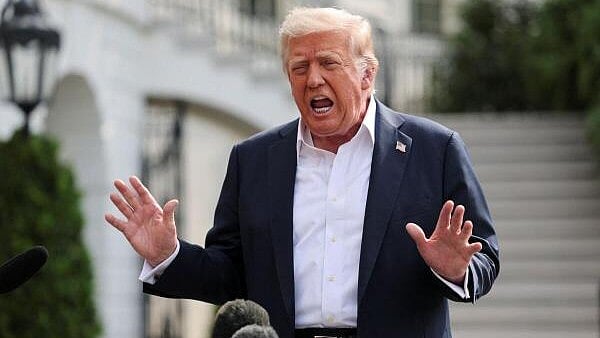
US President Donald Trump
Credit: Reuters Photo
New Delhi: US President Donald Trump’s announcement regarding imposition of 10% extra tariffs on BRICS nations and the bill proposing a 500% penalty on countries buying Russian oil would further complicate the proposed India-US trade deal as both these moves indicate America’s leveraged arm-twisting tactics, experts said.
“Washington’s recent actions make it clear that what it offers are not traditional free trade agreements, but MASAL deals—Mutually Agreed Settlements Achieved through Leveraged Arm-twisting,” said Ajay Srivastava, founder of the Global Trade Research Initiative (GTRI).
India and the US were widely expected to sign a mini trade deal before the July 9 deadline of the imposition of the so-called reciprocal tariffs. The Trump administration has extended the deadline till the end of this month. Trump has announced that the reciprocal tariffs will come into effect from August 1.
As per Trump’s announcement, the US will impose additional 26% tariffs on Indian goods effective from August 1, if there is no trade deal between the two countries. This will be in addition to 10% flat tariffs implemented since April.
While pushing India to sign such a deal, the US has simultaneously proposed a 10% tariff on all BRICS nations, including India, accusing them of undermining the dollar. It has also introduced a bipartisan bill to impose 500% tariffs on countries that continue buying Russian oil and gas—directly targeting India’s energy security.
“These aggressive moves indicate that even after a deal, the US may still impose new tariffs on political grounds. India must factor in these risks, safeguard its strategic and economic autonomy, and ensure that any agreement genuinely serves long-term national interests,” said Srivastava.
Russia accounts for more than one-third of India’s total crude oil imports. India has boosted imports of the Russian crude since 2022 after energy prices surged in the global markets following the outbreak of the Russia-Ukraine conflict.
As per vessel tracking data released by the global commodity market analytics firm Kpler, on an average India imported 2.08 million barrels per day (bpd) of Russian crude in June, which is around 40% of the country’s overall crude imports of around 5.4 million barrels per day.
Union Minister for Petroleum and Natural Gas Hardeep Singh Puri said India’s decision to buy Russian crude contributed significantly to global energy security.
According to Puri, discontinuation of the Russian oil trade would have pushed the crude oil prices in the global markets beyond $120-130 per barrel.
Over 85% of India’s oil needs are met through imports. India is now heavily dependent on Russian oil for its energy security. India may find it difficult to buzz the Russian oil import issue to have a trade deal with the US.
Trump’s threat against BRICS is also equally disturbing for India, which is the founding member of the 10-nation bloc.
The bloc was originally known as BRIC comprising four countries Brazil, Russia, India and China. South Africa joined the group in 2010 and thus the acronym was expanded to BRICS. Five more countries Egypt, Ethiopia, Indonesia, Iran, and the United Arab Emirates joined the group recently.
Trump has termed the BRICS grouping as “anti-American” and a threat to the US dollar.
Srivastava argued that several countries have been forced to look for alternatives as the US weaponised its currency.
“By blocking access to dollar-based payments through sanctions and cutting off nations like Russia, Iran, and Venezuela from the SWIFT system, the US left many countries with no choice but to seek alternatives. The dollar wasn’t pushed out—it shut the door on itself,” he said.
The Society for Worldwide Interbank Financial Telecommunication (SWIFT) was founded in 1973 by 239 banks from 15 countries. It connects over 11,000 banks in more than 200 countries. The SWIFT was designed to be a neutral platform for trade-related payments. However, it has been frequently misused by the US.